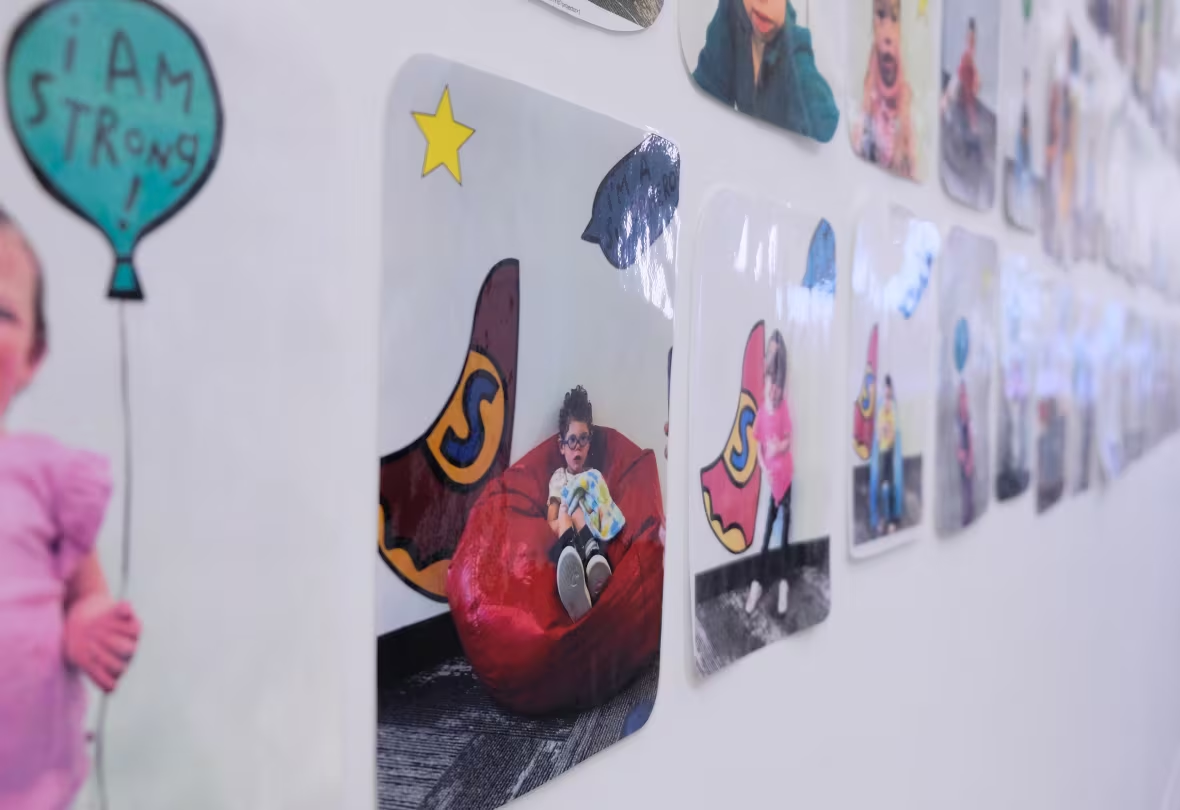Max Labelle's face lit up the first time he tried out a Trexo Robotics exoskeleton.
Max, who is four years old, was born with hypotonic cerebral palsy, a lack of stability in his muscles that makes sitting and standing difficult and walking even more so.
The exoskeleton was a game changer. It supports Max's torso and helps him lift his legs as he practices taking steps during physiotherapy sessions.
Those sessions were a long way from home.
Max and his family travelled from Maple Ridge, B.C., to the Canadian Centre for Development in Calgary, where he first experienced the exoskeleton. It's one of just a handful of places in Western Canada that has one.
 A picture of Max Labelle relaxing in a beanbag chair hangs on the 'Intensive Warriors' wall at the Canadian Centre for Development in Calgary. (Josh McLean/CBC)
A picture of Max Labelle relaxing in a beanbag chair hangs on the 'Intensive Warriors' wall at the Canadian Centre for Development in Calgary. (Josh McLean/CBC)His mom, Jamie Labelle, says it didn't take long to see a difference in Max. Within a week his posture improved and he was using his legs a lot more.
"You knew right away that he needed to have this," Labelle told CBC News. "He loved either the sensation or the movement itself of being as close to a typical child walking and playing as he could."
But that moment of excitement was deflated when Labelle learned the cost of the device — $40,000. An amount not covered by public health insurance.
"You get introduced to these pieces of equipment that are awesome," she said. "Then you do the price check and the price check is a gut punch."
To help with the cost, a relative started raising money for Max online. They're not the only ones taking that approach.
Searching "Trexo" on GoFundMe yields dozens of results from Canada and around the world. Some families have managed to raise the money. Others have a long way to go.
For kids like Max, time is of the essence. There is a limited window when treatment is effective. If a child with cerebral palsy doesn't learn to walk by the age of six or seven, it's unlikely they ever will, according to Julie Rubin, executive director of the Canadian Centre for Development.
"All the way up to five years old, there's still a lot of development in the brain," said Rubin. "So the more supports we can provide to a child, the more able-bodied they'll be down the road."
Around 85 kids have had a chance to use the exoskeleton at the centre. Some of them, including Max, travelled from out of province for the opportunity.
Trexo Robotics, the Mississauga-based company behind the exoskeleton, acknowledges the high cost of the device.
"It is a total game changer for these families, but it is expensive technology, there's no question," said Trexo's customer success manager Marc Robert.
"They're not everywhere that they are needed because they have to be paid for by families as opposed to by governments."
Robert's own son uses one of the exoskeletons. Like other families, he had to rely on fundraising to cover the cost. His son now uses the device to make the kilometre-long walk to the farmers market to get groceries on weekends.
As for Max's family, after the initial sticker shock wore off they haven't been deterred by the high cost of the exoskeleton. So far, they have fundraised nearly three-quarters of their $40,000 goal.
"I'm not going to stop until we can get this piece of equipment for him," said Jamie Labelle.











